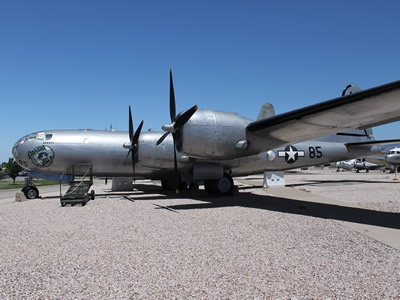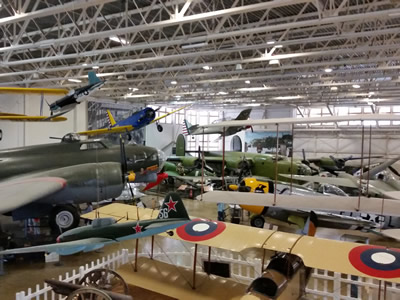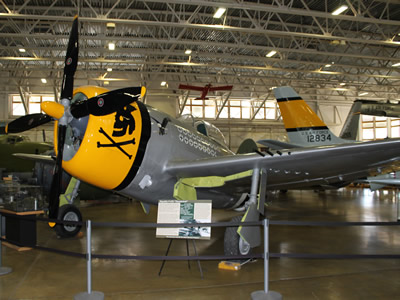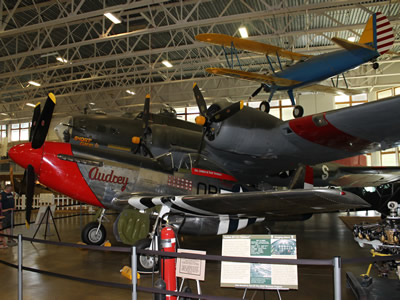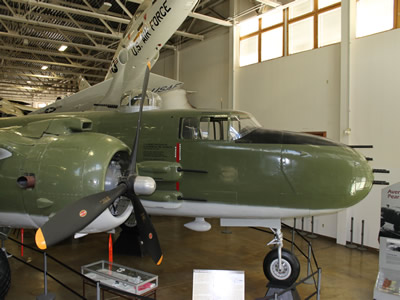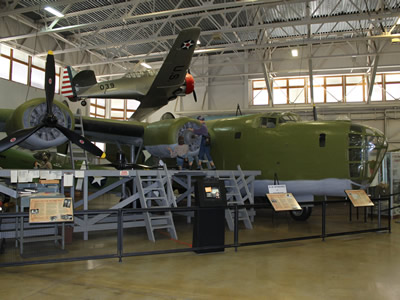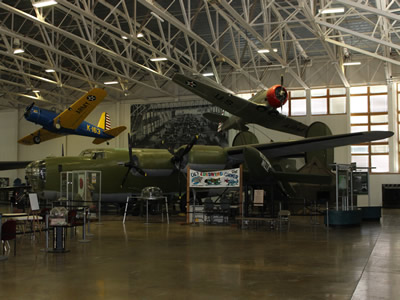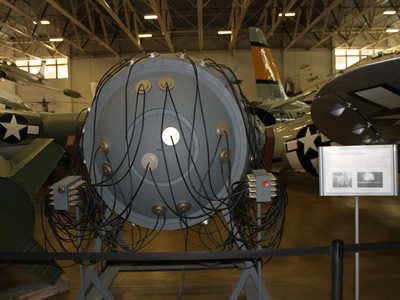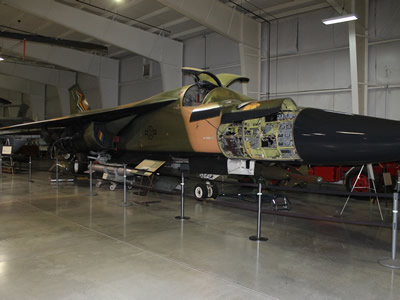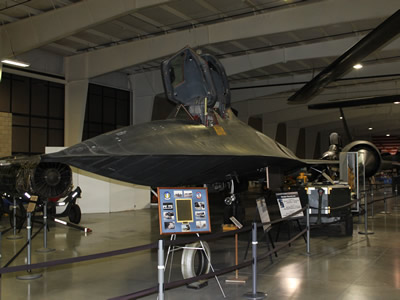Hill Aerospace Museum
NOTE: This spring and summer were very busy, as well as very eventful for me. I got way behind with posting on the Dog Blog. I am going to try to catch up, and as I do I will post events in chronological order. Some of them were a while ago but I will write what I remember.
The biggest wargame convention that I have been to is Consimworld Expo (CSWE) in Tempe Arizona. Although I haven't been able to attend since I started working at U of I, this year I was determined to go. I don't like to fly to game conventions because I can't take my games with me. But it's a long drive from Boise to Phoenix. It's either one very long day or an easy two day drive. For the trip down, I opted for the leisurely two day version. That would allow me to make stops and side trips along the way. I decided it was a good opportunity to do something that I had been wanting to do for quite some time - visit the Hill Aerospace Museum. It's located at Hill Air Force Base which is just south of Ogden Utah. The museum is right next to the interstate so if I took the I15 route to Tempe through Salt Lake City and Las Vegas, I would drive right by it.
I had been there for a very brief visit back in December 2003. That time, it had also been a stop on a drive down to Phoenix. Over Christmas break, Mickey and I went to see the New York Rangers play the Phoenix Coyotes, Mickey's first ever NHL game. We stopped at the museum but were there just before it closed so we had to rush through. I remember that there were a lot of neat aircraft on display. The one that stood out in my memory was an SR71 Blackbird, one of the most amazing airplanes ever built (more on that later). Other than that one quick visit to the museum, I had only seen the SR71 one other time at an airshow. So I always wanted to go back so I could see everything that the museum had to offer. But like a lot of things that you "mean to do someday", it never happened. For all the times I have driven by it on trips, it seems that it's always too late, or I'm in too much of a hurry to get somewhere, or it's Sunday (the museum is closed - it is in Utah after all), or the person I'm traveling with isn't interested.
Now I finally had my chance. I have always been fascinated by airplanes. I love to go to airshows, and I have seen the Blue Angels and Thunderbirds more times than I can count. When I was growing up, my hobby was building model airplanes. That's how I spent a lot of my spare time during grade school and all the way through high school. I was especially interested in aircraft from the second world war. I built dozens of models, carefully assembling them, and researching photos so that I could paint them with the markings of actual aircraft that flew during the war. When I was in Milwaukee this spring helping my dad clean out his basement, he still had an old 1/72nd scale model of a B24 Liberator that I had built and painted to match the airplane that he had flown in World War II, the What's Cookin' Doc. The landing gear were broken and most of the propeller blades were missing but he had still saved that model for fifty years.
Since I had no reason for an extremely early start for my trip, I got to the museum just after noon. Although it was a Friday the parking lot was completely full. I did manage to find a spot though, parking along the side of the access road. I guess it was a good thing that I didn't try to come on a Saturday.
I started by walking through the outdoor exhibits. They have a lot of airplanes on display and airplanes are pretty big, so a lot of them are just parked outside of the museum. There are some big jet bombers, like a B47 and a B52, as well as quite a few large transport aircraft. There was an F89 Scorpion, a night fighter that I had to admit as I was looking at it was actually quite ugly but which I thought was super cool when I was a young kid. I built several models of it back in the day.
My favorite airplane by far among the outside exhibits was the B29 Superfortress, a WWII bomber. They are pretty rare and I have only seen one a couple of times. Out of almost four thousand B29's built, there is only one flying B29 left. Up close it was a BIG airplane, especially for that time period. During WWII the B29 was the primary aircraft used for the strategic bombing campaign against Japan. It crippled Japanese industry and caused tremendous devastation to Japanese cities. It is also the only airplane in history to use nuclear weapons during wartime.
Besides the outdoor exhibits, the museum has two very large hanger-type buildings. The first had a lot of WWII aircraft. There were all of the famous US planes from that war. There was a P51 Mustang. It's graceful lines make it, in my opinion, the most beautiful airplane ever designed. It might have been the best fighter plane of the war too. The P47 Thunderbolt, the Mustang's ugly cousin, is just a huge engine with stubby wings. But it was fast and and very effective. There was a P38 Lightning, the first fighter the US had in Europe that had the range to follow allied heavy bombers on missions deep into Germany. Because of it's unusual appearance it was called the "fork-tailed devil" by German Luftwaffe pilots. There was a B17 Flying Fortress, probably the most famous bomber of the war and the backbone of the US army air forces in the strategic bombing campaign against Germany. There was a B25 Mitchell medium bomber, named for General Billy Mitchell, a proponent of air power between the wars who was from my home town, Milwaukee. The airport there is named Mitchell Field in his honor. At the entrance to the airport there is a B25 Mitchell bomber mounted to appear to be in flight. I'd driven by that B25 many times over the years as I was growing up so the airplane was very familiar to me.
And there was a B24 Liberator. During WWII my dad was a tail gunner on a B24 flying bombing missions over Germany. Although less famous than the B17, the Liberator was faster, flew higher, and carried a bigger bomb load than the B17. More B24's were flown by the eighth air force than B17's. But it isn't as glamorous an airplane and isn't as well known.
This museum had a B24 D, with the large plexiglas nose. My dad flew in a B24J, a later version which had a gun turret mounted in the nose to give it more protection against enemy fighters. But I was still excited when I took a picture on my phone and immediatly sent it to my dad with the message "Hey, I'm standing in front of a real B24!".
Besides all of the vintage airplanes there was another exhibit that I found fascinating, a replica of the very first atomic bomb ever detonated, known simply as "The Gadget".
The Manhattan Project, which developed the atomic bomb during the war, actually developed two designs. One was simple but inefficient, and used highly enriched uranium 235, which was very difficult to produce. This design was called Little Boy and basically consisted of a canon that fired one piece of U235 into another piece of U235. The impact was sufficient to produce critical mass and resulted in an atomic explosion. Because of the simplicity of the design and the scarcity of enriched uranium, no test of the design was done before it was used in the bomb that was dropped on Hiroshima on August 6, 1945. It detonated successfully and produced an explosion estimated to be equivalent to 13 kilotons of TNT. It killed 66,000 people and injured 69,000.
The other bomb design, designated Fat Man, used plutonium 239. Since PU239 is a byproduct from nuclear reactors, it was much easier to obtain. But it was more difficult to use to produce an atomic explosion. The approach taken was to shape the plutonium into a hollow sphere which was surrounded by a sphere of conventional explosives. When the outer sphere was detonated the plutonium was compressed to critical mass by the explosion. It required great precision in the shaping of the plutonium and the conventional explosives as well as the placing of the triggers to have a successful detonation rather than a "fizzle"..
Because of the complexity of the design a test was conducted, designated Trinity, at Los Alamos, New Mexico. The first nuclear bomb, known only as The Gadget, was detonated on July 16, 1945, producing a yield of 20 kilotons. When a similar device was dropped on Nagasaki on August 9, 1945, it killed between 60,000 and 80,000 people. The destruction was so great that exact casualty figures could never be determined.
The Trinity test represented perhaps the most important point in the history of humanity, the moment that we gained the ability to totally destroy our civilization and maybe even to exterminate our entire species. I spent a long time looking at The Gadget. It was fascinating but horrible. It's sad that we ever had to use human ingenuity to create such devices of destruction.
I remembered a story that I had read about the Trinity test. While most of the engineers and scientists, who had worked so hard on the project, were celebrating their technical successf, Robert Oppenheimer, the physicist in charge of the project, just stared grimly at the mushroom cloud. Then he quietly quoted Vishnu's words in the Hindu holy book, the Bagavad Gita "Now I am become Death, the destroyer of worlds".
When I finally snapped out of my morbid reverie I moved on to the second museum building. It featured mainly post-WWII jet aircraft. There were a number of jet fighters that I recognized right away, the F4, the F102, the F106. There was also an F111, an aircraft that had avionics that my dad had worked on. Most interesting was an SR71, one of the most amazing aircraft ever built. It was faster, and could fly higher, than any other aircraft ever built. It was designed at the legendary Lockheed Skunk Works. It was one of three aircraft designed there (the other two being the U2 and the F117) that were such incredible advances over the state of the art that the term skunk works has gone into popular usage (at least among engineers) with any maverick R&D effort that pushes what is possible. For any engineers, or anyone interested in engineering, I would highly recommend the book Skunk Works by Ben Rich.
The SR71 is my own personal choice as the most amazing engineering project ever done. The design was started in 1960 and the first test flight was made in 1962. Even though it was designed over fifty years ago, no airplane since has been able to fly as high or as fast. It also was the first aircraft to have stealth features built in, which weren't fully realized until the F117 fighter and B2 bomber were designed over twenty years later.
I remembered a story about the SR71 that I heard years ago from a friend at HP. His brother was an airline pilot, and said he overheard the following conversation between an SR71 and a civilian air traffic controller.
ATC: "SR71. Please state your speed and altitude."
SR71: "I'm sorry. That's classified."
ATC (irritated): "SR71, you are in my airspace and I am responsible for the safety of all aircraft in it. State your speed and altitude."
There was silence for a moment, and then the SR71 replied "Don't worry. There's no one else here."
I don't know if that story is true or not, but it is such a good story it should be true.
Finally after touring all the exhibits I had to stop at the museum gift shop on the way out. I was expecting a lot of cool airplane stuff: books, tshirts, caps. To my surprise, they didn't really have anything that interested me. Oh well. I figured that I would still have a lot of opportunity on this trip to buy stuff, wargames especially, at Consimworld Expo. And even without a tshirt, I had enjoyed the visit to the museum tremendously.
I was back in my car, and back on the road, heading for Consimworld Expo.
